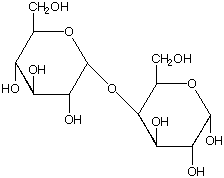| 1.
| In the process of hydrolysis, di- and polysaccharides can be broken down into the monosaccharides that make it up. What should occur if a sample of sucrose was hydrolyzed and the resulting solution subjected to a Benedict's Test?
|
| 2.
| The Fehling's Test is another carbohydrate test. The solutions required to perform a Fehling's Test are copper (II) sulfate, sodium potassium tartrate and sodium hydroxide. Which of the tests in this experiment is a Fehling's Test most similar to? Explain your choice.
|
| 3.
| Allose is a compound that gives positive results when subjected to a Molisch Test, Benedict's Test, Barfoed's Test and Seliwanoff's Test but a negative result with Bial's Test. Describe, in as much detail as possible, the structure of allose.
|
| 4.
| The structure for threose is shown below. Threose does not fall into any of the classifications of monosaccharides in this experiment (aldopentose, aldohexose, ketopentose or ketohexose). Predict the name of the category into which it falls?

|
| 5.
| Trehalose has the structure shown below.
a. If trehalose is hydrolyzed, what monosaccharide(s) are produced?
b. Is it a reducing sugar?

| 6.
| Name the single test that would best be able to distinguish between each of the following pairs of compounds. To see the structure of each, click on the name. Explain your choice.
a. ribose and ribulose
b. sucrose and fructose
c. altrose and lyxose
| 7.
| Raffinose is found in sugar beets and has the structure shown below. It would be best described by the term ____saccharide (you may not use the poly to fill in the blank)?

| | |









